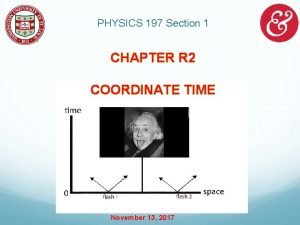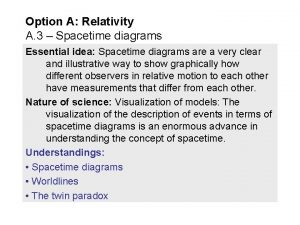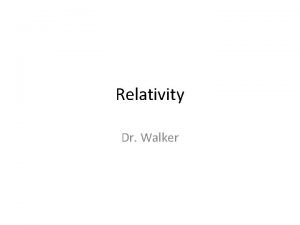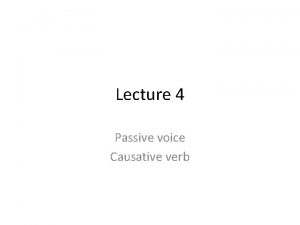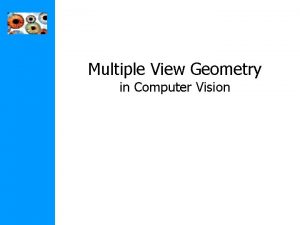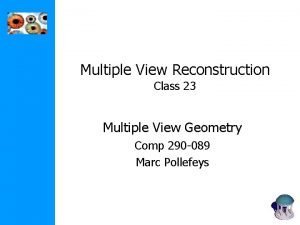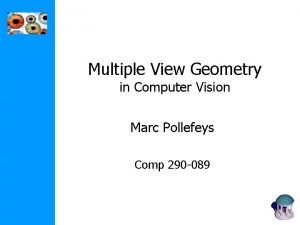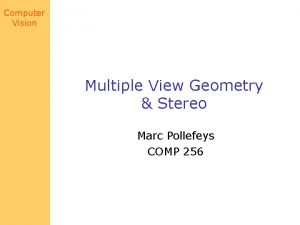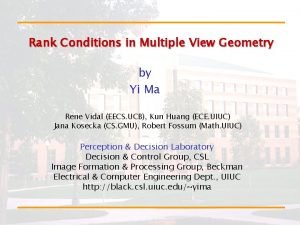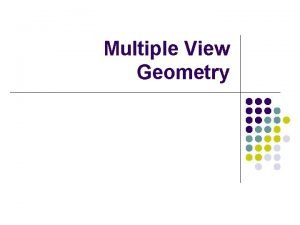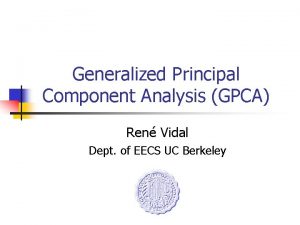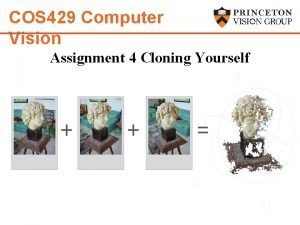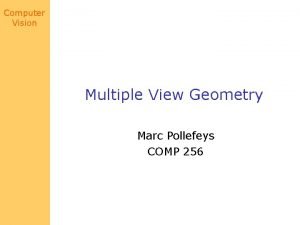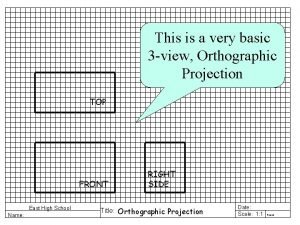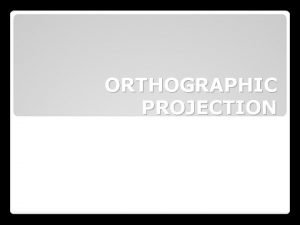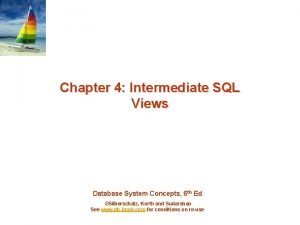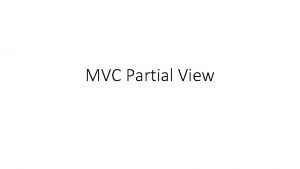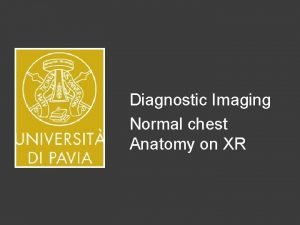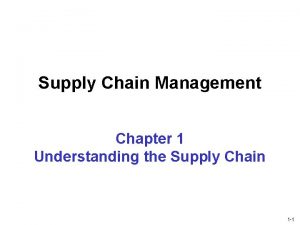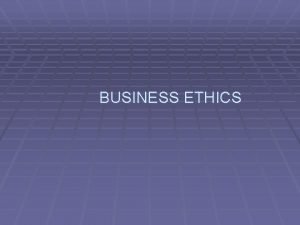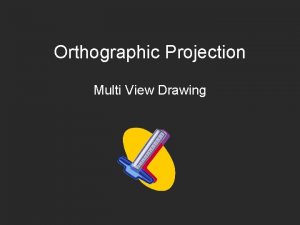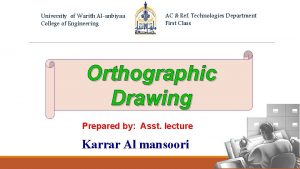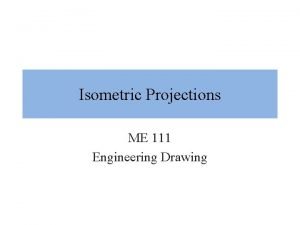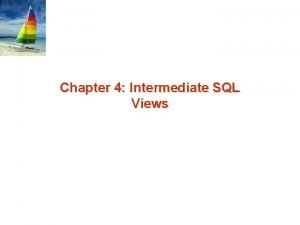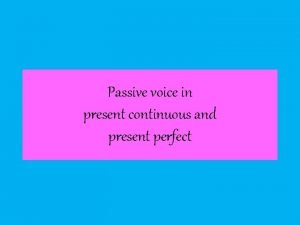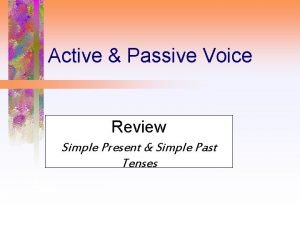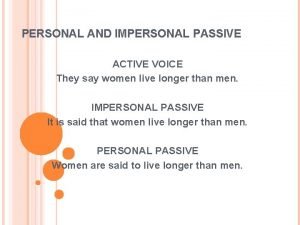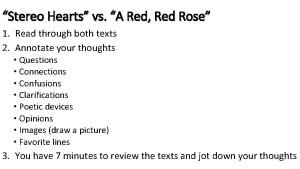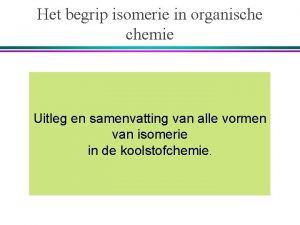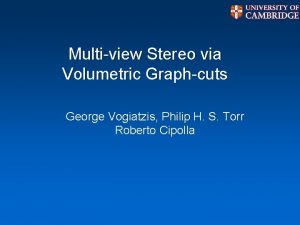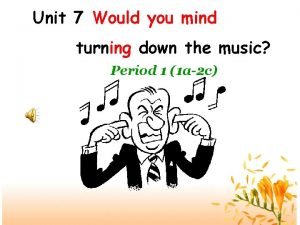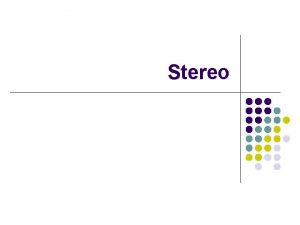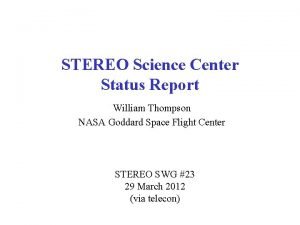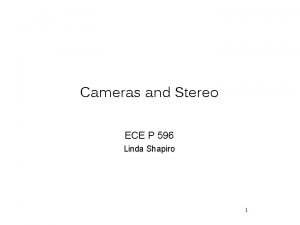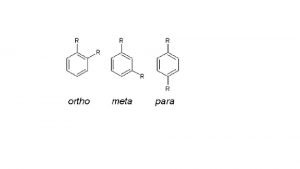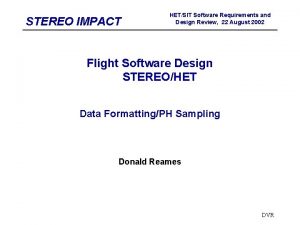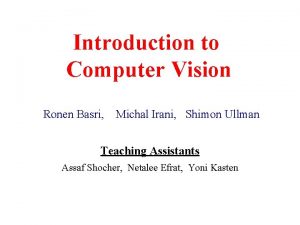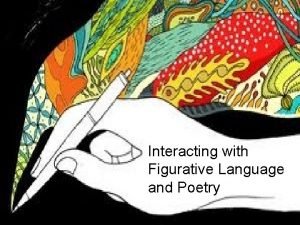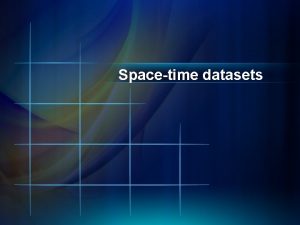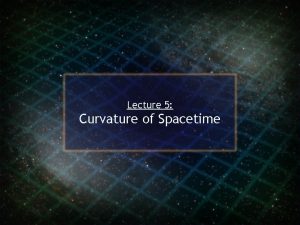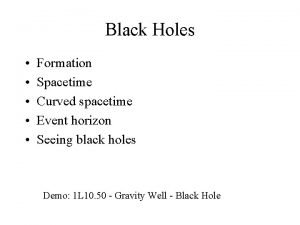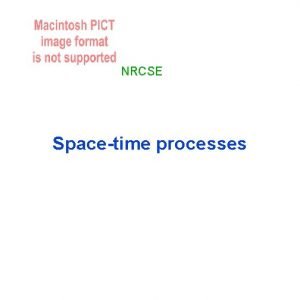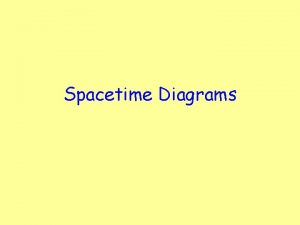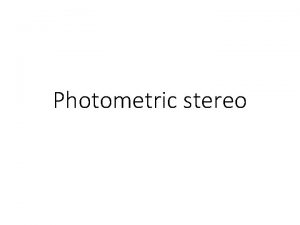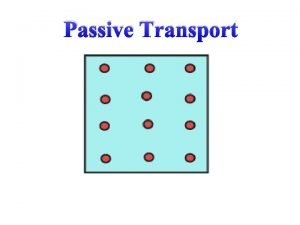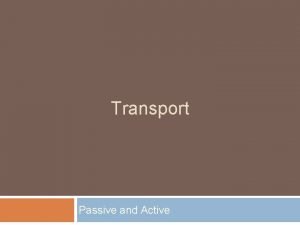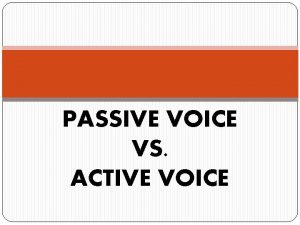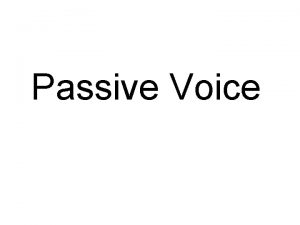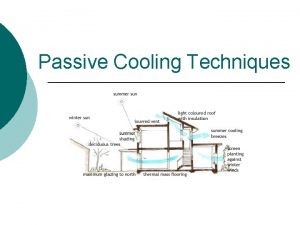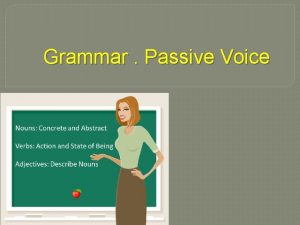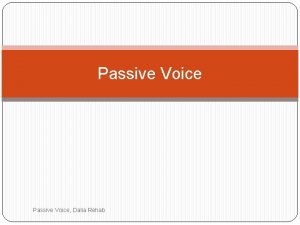Last lecture Passive Stereo Spacetime Stereo Multiple View
























![Normalized 8 -point algorithm [x 1, T 1] = normalise 2 dpts(x 1); [x Normalized 8 -point algorithm [x 1, T 1] = normalise 2 dpts(x 1); [x](https://slidetodoc.com/presentation_image/996107cd03e8db776c333b7897163158/image-25.jpg)
![Normalization function [newpts, T] = normalise 2 dpts(pts) c = mean(pts(1: 2, : )')'; Normalization function [newpts, T] = normalise 2 dpts(pts) c = mean(pts(1: 2, : )')';](https://slidetodoc.com/presentation_image/996107cd03e8db776c333b7897163158/image-26.jpg)

































![Extensions to factorization methods • Paraperspective [Poelman & Kanade, PAMI 97] • Sequential Factorization Extensions to factorization methods • Paraperspective [Poelman & Kanade, PAMI 97] • Sequential Factorization](https://slidetodoc.com/presentation_image/996107cd03e8db776c333b7897163158/image-60.jpg)

















- Slides: 77

Last lecture • Passive Stereo • Spacetime Stereo • Multiple View Stereo

Today • Structure from Motion: Given pixel correspondences, how to compute 3 D structure and camera motion? Slides stolen from Prof Yungyu

Epipolar geometry & fundamental matrix

The epipolar geometry What if only C, C’, x are known?

The epipolar geometry demo C, C’, x, x’ and X are coplanar

The epipolar geometry All points on project on l and l’

The epipolar geometry Family of planes and lines l and l’ intersect at e and e’

The epipolar geometry epipolar pole epipolar geometry demo = intersection of baseline with image plane = projection of projection center in other image epipolar plane = plane containing baseline epipolar line = intersection of epipolar plane with image

The fundamental matrix F p R p’ C’ C T=C’-C The equation of the epipolar plane through X is

The fundamental matrix F essential matrix

The fundamental matrix F p R p’ C’ C T=C’-C

The fundamental matrix F Let M and M’ be the intrinsic matrices, then fundamental matrix

The fundamental matrix F p R p’ C’ C T=C’-C

The fundamental matrix F • The fundamental matrix is the algebraic representation of epipolar geometry • The fundamental matrix satisfies the condition that for any pair of corresponding points x↔x’ in the two images

The fundamental matrix F F is the unique 3 x 3 rank 2 matrix that satisfies x’TFx=0 for all x↔x’ 1. Transpose: if F is fundamental matrix for (P, P’), then FT is fundamental matrix for (P’, P) 2. Epipolar lines: l’=Fx & l=FTx’ 3. Epipoles: on all epipolar lines, thus e’TFx=0, x e’TF=0, similarly Fe=0 4. F has 7 d. o. f. , i. e. 3 x 3 -1(homogeneous)-1(rank 2) 5. F maps from a point x to a line l’=Fx (not invertible)

The fundamental matrix F • It can be used for – Simplifies matching – Allows to detect wrong matches

Estimation of F — 8 -point algorithm • The fundamental matrix F is defined by for any pair of matches x and x’ in two images. • Let x=(u, v, 1)T and x’=(u’, v’, 1)T, each match gives a linear equation

8 -point algorithm • In reality, instead of solving , we seek f to minimize , least eigenvector of.

8 -point algorithm • To enforce that F is of rank 2, F is replaced by F’ that minimizes subject to. • It is achieved by SVD. Let , let then is the solution. , where

8 -point algorithm % Build the constraint matrix A = [x 2(1, : )‘. *x 1(1, : )' x 2(1, : )'. *x 1(2, : )' x 2(1, : )'. . . x 2(2, : )'. *x 1(1, : )' x 2(2, : )'. *x 1(2, : )' x 2(2, : )'. . . x 1(1, : )' x 1(2, : )' ones(npts, 1) ]; [U, D, V] = svd(A); % Extract fundamental matrix from the column of V % corresponding to the smallest singular value. F = reshape(V(: , 9), 3, 3)'; % Enforce rank 2 constraint [U, D, V] = svd(F); F = U*diag([D(1, 1) D(2, 2) 0])*V';

8 -point algorithm • Pros: it is linear, easy to implement and fast • Cons: susceptible to noise

Problem with 8 -point algorithm ~10000 ~1000 0 ! ~10000 ~100 ~10 0 Orders of magnitude difference between column of data matrix least-squares yields poor results 1

Normalized 8 -point algorithm normalized least squares yields good results Transform image to ~[-1, 1]x[-1, 1] (0, 500) (700, 500) (-1, 1) (0, 0) (700, 0) (-1, -1) (1, -1)

Normalized 8 -point algorithm 1. Transform input by 2. Call 8 -point on 3. , to obtain
![Normalized 8 point algorithm x 1 T 1 normalise 2 dptsx 1 x Normalized 8 -point algorithm [x 1, T 1] = normalise 2 dpts(x 1); [x](https://slidetodoc.com/presentation_image/996107cd03e8db776c333b7897163158/image-25.jpg)
Normalized 8 -point algorithm [x 1, T 1] = normalise 2 dpts(x 1); [x 2, T 2] = normalise 2 dpts(x 2); A = [x 2(1, : )‘. *x 1(1, : )' x 2(1, : )'. *x 1(2, : )' x 2(1, : )'. . . x 2(2, : )'. *x 1(1, : )' x 2(2, : )'. *x 1(2, : )' x 2(2, : )'. . . x 1(1, : )' x 1(2, : )' ones(npts, 1) ]; [U, D, V] = svd(A); F = reshape(V(: , 9), 3, 3)'; [U, D, V] = svd(F); F = U*diag([D(1, 1) D(2, 2) 0])*V'; % Denormalise F = T 2'*F*T 1;
![Normalization function newpts T normalise 2 dptspts c meanpts1 2 Normalization function [newpts, T] = normalise 2 dpts(pts) c = mean(pts(1: 2, : )')';](https://slidetodoc.com/presentation_image/996107cd03e8db776c333b7897163158/image-26.jpg)
Normalization function [newpts, T] = normalise 2 dpts(pts) c = mean(pts(1: 2, : )')'; % Centroid newp(1, : ) = pts(1, : )-c(1); % Shift origin to centroid. newp(2, : ) = pts(2, : )-c(2); meandist = mean(sqrt(newp(1, : ). ^2 + newp(2, : ). ^2)); scale = sqrt(2)/meandist; T = [scale 0 -scale*c(1) 0 scale -scale*c(2) 0 0 1 ]; newpts = T*pts;

RANSAC repeat select minimal sample (8 matches) compute solution(s) for F determine inliers until (#inliers, #samples)>95% or too many times compute F based on all inliers

Results (ground truth)

Results (8 -point algorithm)

Results (normalized 8 -point algorithm)

From F to R, T If we know camera parameters Hartley and Zisserman, Multiple View Geometry, 2 nd edition, pp 259

Application: View morphing

Application: View morphing

Main trick • Prewarp with a homography to rectify images • So that the two views are parallel • Because linear interpolation works when views are parallel

Problem with morphing • Without rectification


morph prewarp input homographies prewarp output input


Video demo

Triangulation • Problem: Given some points in correspondence across two or more images (taken from calibrated cameras), {(uj, vj)}, compute the 3 D location X Richard Szeliski CSE 576 (Spring 2005): Computer Vision 40

Triangulation • Method I: intersect viewing rays in 3 D, minimize: • • X is the unknown 3 D point Cj is the optical center of camera j Vj is the viewing ray for pixel (uj, vj) sj is unknown distance along Vj • Advantage: geometrically intuitive X Vj Cj Richard Szeliski CSE 576 (Spring 2005): Computer Vision 41

Triangulation • Method II: solve linear equations in X • advantage: very simple • Method III: non-linear minimization • advantage: most accurate (image plane error) Richard Szeliski CSE 576 (Spring 2005): Computer Vision 42

Structure from motion

Structure from motion Unknown camera viewpoints structure from motion: automatic recovery of camera motion and scene structure from two or more images. It is a self calibration technique and called automatic camera tracking or matchmoving.

Applications • For computer vision, multiple-view shape reconstruction, novel view synthesis and autonomous vehicle navigation. • For film production, seamless insertion of CGI into live-action backgrounds

Structure from motion 2 D feature tracking 3 D estimation SFM pipeline optimization (bundle adjust) geometry fitting

Structure from motion • Step 1: Track Features • Detect good features, Shi & Tomasi, SIFT • Find correspondences between frames – Lucas & Kanade-style motion estimation – window-based correlation – SIFT matching

Structure from Motion • Step 2: Estimate Motion and Structure • Simplified projection model, e. g. , [Tomasi 92] • 2 or 3 views at a time [Hartley 00]

Structure from Motion • Step 3: Refine estimates • “Bundle adjustment” in photogrammetry • Other iterative methods

Structure from Motion • Step 4: Recover surfaces (image-based triangulation, silhouettes, stereo…) Good mesh

Example : Photo Tourism

Factorization methods

Problem statement

Other projection models

SFM under orthographic projection 2 D image point orthographic projection matrix 3 D scene point • Trick • Choose scene origin to be centroid of 3 D points • Choose image origins to be centroid of 2 D points • Allows us to drop the camera translation: image offset

factorization (Tomasi & Kanade) projection of n features in one image: projection of n features in m images W measurement M motion S shape Key Observation: rank(W) <= 3

Factorization known solve for • Factorization Technique – W is at most rank 3 (assuming no noise) – We can use singular value decomposition to factor W: – S’ differs from S by a linear transformation A: – Solve for A by enforcing metric constraints on M

Metric constraints • Orthographic Camera • Rows of P are orthonormal: • Enforcing “Metric” Constraints • Compute A such that rows of M have these properties Trick (not in original Tomasi/Kanade paper, but in followup work) • Constraints are linear in AAT : • Solve for G first by writing equations for every Pi in M • Then G = AAT by SVD

Results
![Extensions to factorization methods Paraperspective Poelman Kanade PAMI 97 Sequential Factorization Extensions to factorization methods • Paraperspective [Poelman & Kanade, PAMI 97] • Sequential Factorization](https://slidetodoc.com/presentation_image/996107cd03e8db776c333b7897163158/image-60.jpg)
Extensions to factorization methods • Paraperspective [Poelman & Kanade, PAMI 97] • Sequential Factorization [Morita & Kanade, PAMI 97] • Factorization under perspective [Christy & Horaud, PAMI 96] [Sturm & Triggs, ECCV 96] • Factorization with Uncertainty [Anandan & Irani, IJCV 2002]

Bundle adjustment

Structure from motion • • How many points do we need to match? 2 frames: (R, t): 5 dof + 3 n point locations 4 n point measurements n 5 • k frames: 6(k– 1)-1 + 3 n 2 kn • always want to use many more Richard Szeliski CSE 576 (Spring 2005): Computer Vision 62

Bundle Adjustment • What makes this non-linear minimization hard? • many more parameters: potentially slow • poorer conditioning (high correlation) • potentially lots of outliers Richard Szeliski CSE 576 (Spring 2005): Computer Vision 63

Lots of parameters: sparsity • Only a few entries in Jacobian are non-zero Richard Szeliski CSE 576 (Spring 2005): Computer Vision 64

Robust error models • Outlier rejection • use robust penalty applied to each set of joint measurements • for extremely bad data, use random sampling [RANSAC, Fischler & Bolles, CACM’ 81] Richard Szeliski CSE 576 (Spring 2005): Computer Vision 65

Structure from motion: limitations • Very difficult to reliably estimate metric structure and motion unless: • large (x or y) rotation or • large field of view and depth variation • Camera calibration important for Euclidean reconstructions • Need good feature tracker • Lens distortion Richard Szeliski CSE 576 (Spring 2005): Computer Vision 67

Issues in SFM • • Track lifetime Nonlinear lens distortion Prior knowledge and scene constraints Multiple motions

Track lifetime every 50 th frame of a 800 -frame sequence

Track lifetime of 3192 tracks from the previous sequence

Track lifetime track length histogram

Nonlinear lens distortion

Nonlinear lens distortion effect of lens distortion

Prior knowledge and scene constraints add a constraint that several lines are parallel

Prior knowledge and scene constraints add a constraint that it is a turntable sequence

Applications of Structure from Motion

Jurassic park

Photo. Synth http: //labs. live. com/photosynth/
 Spacetime coordinates review
Spacetime coordinates review Twin paradox spacetime diagram
Twin paradox spacetime diagram Spacetime walker
Spacetime walker De sitter spacetime
De sitter spacetime 01:640:244 lecture notes - lecture 15: plat, idah, farad
01:640:244 lecture notes - lecture 15: plat, idah, farad Randy pausch the last lecture summary
Randy pausch the last lecture summary Delayed multiple baseline design
Delayed multiple baseline design Multiple instruction single data
Multiple instruction single data Let+object+verb
Let+object+verb Multiple view geometry tutorial
Multiple view geometry tutorial Multiple view geometry
Multiple view geometry Multiple view geometry in computer vision
Multiple view geometry in computer vision Multi view geometry
Multi view geometry Multiple view geometry
Multiple view geometry Multiple view geometry
Multiple view geometry Multiple view geometry
Multiple view geometry Multiple view geometry
Multiple view geometry Tensor notation
Tensor notation Orthographic drawing title block
Orthographic drawing title block Revolved sectional view
Revolved sectional view Section view adalah
Section view adalah What is full section
What is full section Worms eye angle
Worms eye angle Orthographic projection elevation
Orthographic projection elevation There are how many positions of isometric axes
There are how many positions of isometric axes For the view create view instructor_info as
For the view create view instructor_info as Simple view and complex view
Simple view and complex view Simple view and complex view
Simple view and complex view Simple view and complex view
Simple view and complex view Partial views are an effective way to
Partial views are an effective way to Chest x ray lateral view positioning
Chest x ray lateral view positioning Cycle view and push pull view
Cycle view and push pull view Components of operating systems
Components of operating systems Integration view of ethics
Integration view of ethics Multi view drawings
Multi view drawings Front view top view
Front view top view Isometric projection of triangle
Isometric projection of triangle For the view create view instructor_info as
For the view create view instructor_info as Passive view of consumer decision making
Passive view of consumer decision making Present continuous passive form
Present continuous passive form Active present tense
Active present tense Passive voice personal and impersonal structure exercises
Passive voice personal and impersonal structure exercises Present passive progressive
Present passive progressive Simple present to eat
Simple present to eat Tcp stereo
Tcp stereo Stereo hearts simile
Stereo hearts simile Dichloor
Dichloor Functie isomeren
Functie isomeren Would you mind song
Would you mind song Rhyme scheme in stereo hearts
Rhyme scheme in stereo hearts Multiview stereo
Multiview stereo Would you mind not talking in the library.
Would you mind not talking in the library. Fusion stereo problems
Fusion stereo problems Stereo science center
Stereo science center Photometric stereo
Photometric stereo Stereo
Stereo Stereo luz fm tehuacan
Stereo luz fm tehuacan Tuoli
Tuoli 11 stereo
11 stereo Hetsit
Hetsit Ronen basri
Ronen basri My heart's a stereo figurative language
My heart's a stereo figurative language Vowel change plural words
Vowel change plural words Please clean the blackboard
Please clean the blackboard Project procurement management lecture notes
Project procurement management lecture notes Lecture about sport
Lecture about sport Healthy lifestyle wrap up lecture
Healthy lifestyle wrap up lecture Whats nihilism
Whats nihilism Meaning of this
Meaning of this Tensorflow lecture
Tensorflow lecture Theology proper lecture notes
Theology proper lecture notes Strategic management lecture
Strategic management lecture Geology lecture series
Geology lecture series Social psychology lecture
Social psychology lecture In text citation for a lecture
In text citation for a lecture Lecture notes on public sector accounting ghana pdf
Lecture notes on public sector accounting ghana pdf Software project management handwritten notes pdf
Software project management handwritten notes pdf Eurocode 2 lap length table
Eurocode 2 lap length table
